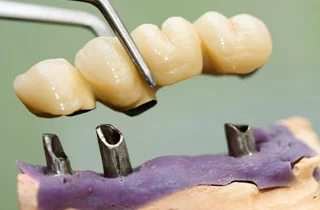Tooth gaps are not only an aesthetic issue. They affect chewing, speech, bite stability – and, let’s be honest: also self-confidence. The dental bridge is one of the most reliable and most frequently used treatments when one or several adjacent teeth are missing. In this guide, we explain in a clear yet professionally accurate way what to expect, how a bridge works, what costs are involved, and according to which criteria you can make a good decision.
We provide support on this topic in our article: 
- What is a dental bridge?
- How long does a dental bridge last?
- Is a bridge cheaper than an implant?
- What are the disadvantages of dental bridges?
- How does the dentist fix the bridge?
- How much does a dental bridge cost?
- When is a dental bridge the right choice?
What is a dental bridge?
A dental bridge is essentially a “bridge” that replaces the gap of a missing tooth. The construction is supported on both sides by abutment teeth – these can be prepared natural teeth or posts fixed on implants. The missing teeth are replaced by the pontic, which the dental technician crafts to look as natural as possible in shape and colour. A well-planned and precisely manufactured bridge does not wobble, move, or “click”. It should feel like your own tooth – stable, comfortable and aesthetic. The goal is not just to close the gap, but also to restore a harmonious bite. Even a single missing tooth can trigger a chain reaction: neighbouring teeth tilt, the bite becomes unstable, and over time, jaw joint or chewing problems may develop.
How long does a dental bridge last?
Durability varies greatly – and that’s not a marketing phrase. According to international guidelines, the average lifespan of a bridge is 8–15 years. However, the range is wide: with good oral hygiene and regular check-ups, a bridge can remain functional for over twenty years, while poor care or unfavourable abutment teeth can lead to a much shorter lifespan. 
Several factors influence the durability of a bridge:
- Health and stability of the abutment teeth,
- Load situation (e.g. night-time grinding or clenching),
- Bridge material (metal-ceramic, zirconia etc.),
- Patient’s oral hygiene,
- Quality of both dental and technical work.
The key message: A bridge is long-lasting, but not a lifetime solution. If your dentist addresses this openly, it is not a weakness – but correct and honest information. Read more about dental implant durability
Is a bridge cheaper than an implant?
In short: yes. At least when it comes to initial costs. An implant requires several treatment steps, a longer healing period, and more expensive materials. A bridge, on the other hand, closes the gap without surgery.
However, it is important to consider the bigger picture:
- A bridge is cheaper in the short term, but removing healthy tooth structure from the abutment teeth is a “hidden cost” – these teeth can become more sensitive or may later require a root canal treatment.
- An implant is more expensive, but neighbouring teeth are not affected and it can last a lifetime with proper care.
The decision is therefore not just a financial one. The condition of the existing teeth, the bone situation, general health and long-term priorities all play a role. Implant or bridge?
What are the disadvantages of dental bridges?
Realistic expectations are important. Bridges are very good treatments, but they also have limitations that should be known.
- Abutment teeth must be ground down – even if they are completely healthy. This is irreversible.
- The area beneath the bridge is more difficult to clean. Without special aids (superfloss, interdental brushes), plaque can accumulate more easily.
- If one abutment tooth develops a problem, usually the entire bridge must be replaced.
- Not every gap can be restored with a bridge. With larger spans, stability may be insufficient.
This does not mean that bridges are poor solutions – quite the opposite. These are simply clinical facts that help ensure an informed decision. In many cases, a bridge remains the most practical treatment.
How does the dentist fix the bridge?
The procedure usually consists of three steps – with healthy teeth and gums, treatment can be completed within two weeks.
1st step: Preparation
The abutment teeth are prepared. This includes tooth reduction, and if needed, a root canal or a build-up. The dentist then takes a precise impression or digital scan.
2nd step: temporary bridge
The temporary bridge protects the prepared teeth and allows a normal daily life until the final restoration is ready. It can be fabricated within a few days.
3rd step: definitive placement
The laboratory-made bridge is fitted, refined and permanently fixed with a special dental cement. The bite is fine-tuned so that the bridge integrates naturally.
The procedure is painless or only slightly uncomfortable. Modern anaesthesia and digital technologies significantly improve the experience.
How much does a dental bridge cost?
The exact cost depends on the bridge type, material, and the quality of the dental laboratory. In most European practices, prices are generally in the following range:
- Metal-ceramic bridge: £305 – £870 per unit
- Zirconia bridge: £392 – £1044 per unit
- Multi-unit bridges: proportionally higher total costs
It is worth viewing the cost of a bridge as an investment. It not only replaces the missing tooth, but improves quality of life, stabilises the bite, and often prevents further tooth movement or wear. Furthermore, a high-quality bridge provides reliability for many years. More about dental bridge costs
When is a dental bridge the right choice?
If you need a fast, reliable and aesthetic solution, a bridge is an excellent option. Especially if the neighbouring teeth already require fillings or dental crowns – in such cases, tooth reduction is not an additional disadvantage. However, if the abutment teeth are completely healthy and you are looking for the most stable long-term solution, an implant should also be considered.
Most importantly: the diagnosis must be personalised. Every mouth is different, every bite is different, every patient is different. A good dentist does not recommend a technique – but a solution that exactly matches your situation. If you have questions or want to find out which option makes more sense in your case, a consultation is worthwhile. And take your time: a good dental restoration will accompany you for many years. Read more about Our dental bridge experiences, and dental restorations in Hungary


